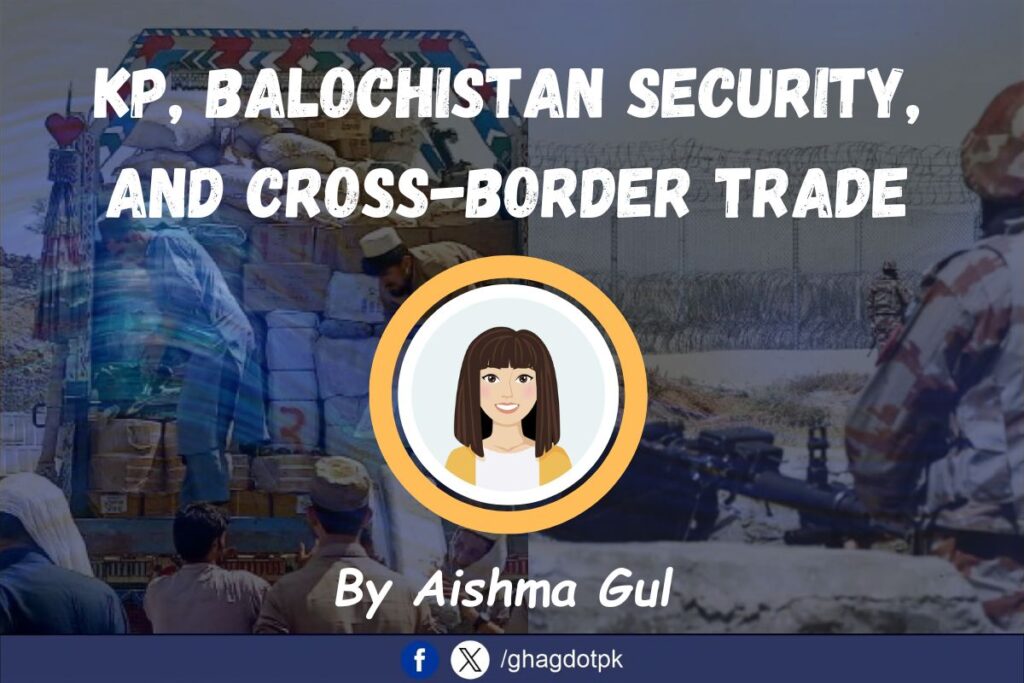By Aishma Gul
“Trade connects where borders divide.”
The border markets in Pakistan’s Khyber Pakhtunkhwa (KP) and Balochistan regions have the potential to improve both the country’s economy and security. These areas, located next to Afghanistan and Iran, are perfectly positioned to encourage trade and economic activity. However, building these markets hasn’t been easy. The challenge lies in balancing security needs with economic goals.
Major Border Crossings and Trade
KP shares a long 2,640-kilometer border with Afghanistan, most of it along the Durand Line. Key trade routes in this area include Torkham and Ghulam Khan. In Balochistan, important crossings like Chaman and Taftan connect Pakistan to Afghanistan and Iran. These points allow goods to move across borders, creating trade opportunities that can benefit local communities and strengthen ties with neighboring countries.
The trade includes a variety of goods. Pakistan exports items such as textiles, medicines, construction materials, sugar, and wheat to Afghanistan. In return, Afghanistan sends fresh and dried fruits, coal, and minerals. With Iran, Pakistan exports rice, livestock, and surgical tools while importing oil, LPG, and iron. According to data from the United Nations COMTRADE database, Pakistan’s exports to Afghanistan in 2023 amounted to $969.04 million, while imports were $691.43 million.
The Economic Importance of Border Markets
These markets are more than just places for buying and selling goods. They provide jobs for local people, help reduce smuggling, and improve cross-border connections. Goods like livestock, cotton, iron ore, and marble have been included in trade agreements, highlighting the strategic value of these resources. The government is also looking into partnerships with Afghanistan and Iran in areas like mining and agriculture to deepen economic cooperation. Agreements like the Pakistan-Afghanistan Transit Trade Agreement (APTTA) and bilateral trade deals with Iran further boost the potential of these border markets to drive regional growth.
The Challenges in Developing Border Markets
Building border markets hasn’t been without challenges. Security remains a big issue. These regions have often seen smuggling and illegal crossings, making it essential to secure trade routes and protect communities. Pakistan’s military and law enforcement agencies have worked hard to tackle these concerns by improving border surveillance and building fences.
Another major issue is the lack of proper infrastructure. Roads, warehouses, and modern trade centers are either missing or insufficient, which slows down trade and forces businesses to rely on outdated methods. For example, sudden closures of trade points like Torkham and Chaman due to disputes or security threats can disrupt the supply chain, causing problems for both traders and consumers. Customs delays, especially for perishable goods like fruits and vegetables, add further complications. To solve these problems, the government needs to invest in modern trade facilities and create stable trade policies. Regional instability and fluctuating relations with neighboring countries have also made it difficult for these markets to grow consistently.
Government and Military Initiatives
The government is taking steps to boost border trade and help local communities. In 2021, it approved plans to set up 18 border markets aimed at reducing illegal trade and supporting local businesses. Markets like Gabd, Mand, and Angoor Adda are already operational. The Pakistan Army and Frontier Corps are ensuring these markets and trade routes are secure by tackling threats from insurgents.
To make trade smoother, Pakistan is also following international agreements like APTTA. Tracking systems for cargo and better road infrastructure, such as the Indus Highway and the Quetta-Karachi Road, are being developed to improve connectivity and reduce delays.
Pakistan has a strong trade partnership with China, its close ally. Through the Khunjerab Pass, both countries trade goods like machinery, textiles, and electronics. In contrast, trade with India through the Wagah-Attari border has currently stopped because of political tensions, even though there’s a lot of potential. Pakistan could send products like textiles and cement to India and get tea, spices, and medicines in return. If relations improve, both countries could benefit greatly from increased trade.
The border markets in KP and Balochistan are not just trading hubs—they are key to building peace and prosperity in the region. Overcoming challenges will require consistent investments in infrastructure, better security, and stronger relationships with neighboring countries. By focusing on these areas and supporting local communities, Pakistan can turn these markets into thriving centers of trade and growth.






